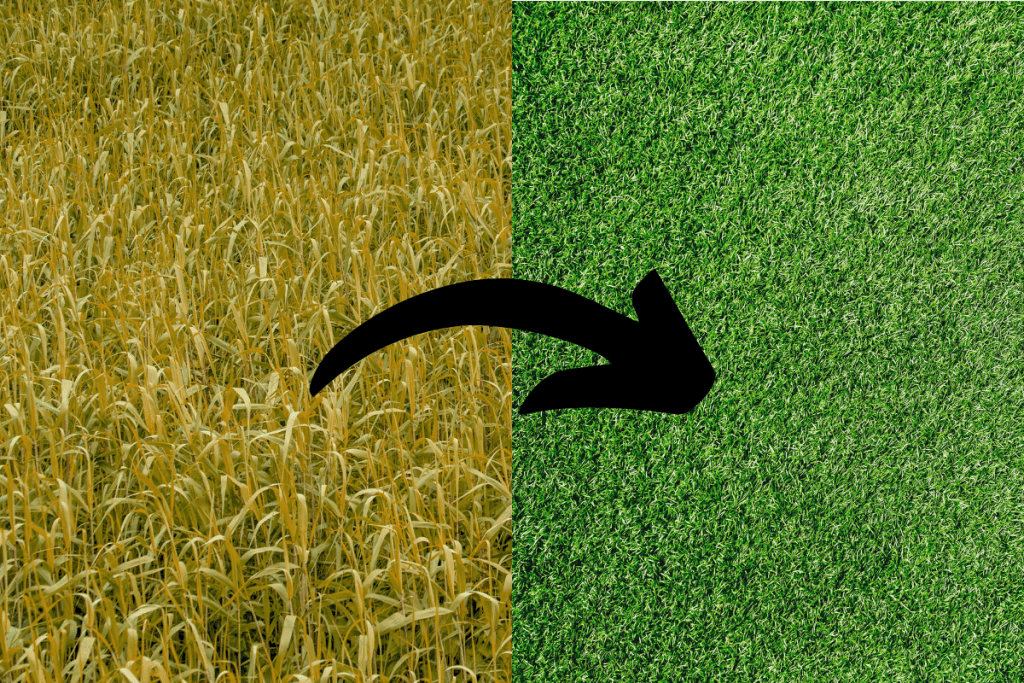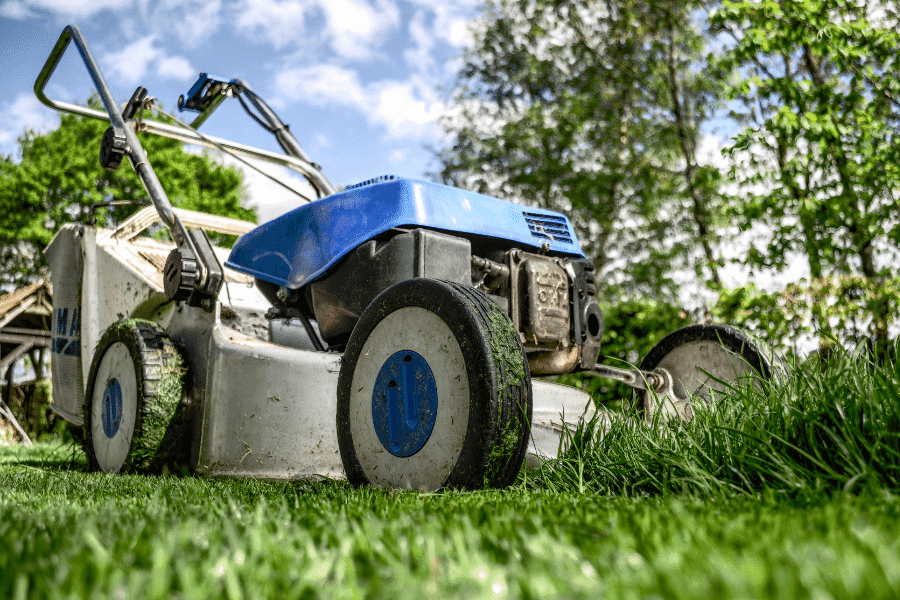Dull, dry, yellow grass will make your whole lawn look drab and unpleasant.
Thankfully, there are lots of fast and easy methods to keep your grass looking green and healthy, regardless of the season or the environmental conditions where you live!
Here are 10 of our favorite lawn care tactics to turn your yellow grass green–just like the pros!

Table of Contents
Always Keep Your Mower Blades Sharp
Proper mowing goes a long way when it comes to maintaining a healthy, beautiful lawn, regardless of the type of grass in your yard.
One of the most important factors to keep in mind when mowing is the sharpness of your mower blades!
Dull lawnmower blades won’t cut your grass properly or evenly.
Instead, the blades will end up tearing up the individual blades of grass, leaving them more susceptible than ever to pest infestations and sun damage.
The torn, ragged grass will also be more prone to fungal growth, which will damage your entire yard in the long run and be costly to treat and remove.
Keeping your lawnmower blades sharp will ensure the grass gets an even, great-looking cut every time.
When it is cut correctly, biological signals are sent to the grass to tell it to grow back thicker and stronger.
The grass will also be able to spread more efficiently horizontally, so it’ll fill in any yellow or bare patches faster, too!
It’s a good idea to sharpen your mower blades every two to three months for best results, though this amount of time varies slightly depending on the size of your yard and how frequently it needs to be mowed.
If it’s been a while since you’ve sharpened your blades and your lawn is looking dull and uneven, it’s probably time for some maintenance!
Water Your Grass Often and Early
One of the main contributors to yellow lawns everywhere is simply a lack of proper hydration.
Watering your lawn regularly and early in the morning is a great and simple way to ensure your yard gets and maintains the moisture levels it needs to stay healthy and green.
As a general rule, it’s a good idea to water your lawn a couple of times per week.
You’ll likely need to water slightly more often in the summer and possibly less often in the winter, depending on where you live and other environmental conditions like how often it rains and how much damage your lawn has already sustained.
In addition to watering often, the time of day you water your grass matters a lot, too.
Most experts recommend watering your grass before 10:00 AM, as the cooler temperatures and calmer winds during the morning hours prevent the water from evaporating before it has a chance to soak into the soil.
If you’re not an early bird yet, it will help to get in the habit of getting up early on days you have to water your lawn.
Keeping your grass adequately hydrated will keep it greener for longer.
Fertilize, Fertilize, Fertilize
Another critical tip often overlooked by many homeowners is fertilizing your lawn frequently and thoroughly.
One of the most common reasons grass turns yellow, dry, and brittle is that it lacks the nutrients it needs to stay green and healthy namely nitrogen.
All you need is a means of spreading the fertilizer and a practical, inexpensive fertilizer designed for most types of grass, such as Scotts Turf Builder Lawn Food.
Speaking of this brand, check out how long it take Scotts Weed and Feed to work.
Be sure to water your lawn thoroughly beforehand, so the fertilizer soaks into the soil properly.
If you want to save time, it helps to use an actual fertilizer spreader tool such as Scotts Turf Builder EdgeGuard Spreader.
This isn’t entirely necessary, as it’s certainly possible to spread it yourself, but it will ensure the fertilizer gets more evenly and quickly distributed throughout your yard.
Be sure to fertilize the perimeter of your yard first before gradually filling in the spots in the middle.
It’s recommended to fertilize at least four times a year, or once every season, for best results and to prevent nutrient deficiency.
Keep Pet Urine Off Your Lawn
If you notice your lawn has lots of small, isolated yellow patches throughout and your dog has free roam of your yard, it might be time to walk your pup elsewhere or designate a single spot in your yard for them to do their business.
Pet urine such as dog and cat urine is packed with heavily concentrated nitrogen compounds, which is why those urine spots will quickly burn up your grass and turn it yellow.
Sure, a small amount of nitrogen is helpful for a healthy lawn and plant growth, but exposing your yard to it in such high amounts will kill it over time.
Never Mow Wet Grass
It’s important to never water your grass when it’s wet for a variety of reasons.
Most importantly, wet grass tends to clump up and bend when you go over it with a mower.
In turn, the grass won’t be cut evenly, as certain patches will be left untouched, bent, or worse, unevenly torn.
The hazard here is a bit similar to the one presented when cutting your grass with dull lawn mower blades.
Uneven, torn grass won’t grow back properly, and it will be much more prone to insect infestation, diseases, and certain types of fungal growth, making it even more yellow and unhealthy than before mowing.
Avoid Lawn Scalping

If your grass is turning yellow and dry, there’s a good chance you’re cutting it either too short, too often or both.
As a general rule, you never want to trim more than ⅓ of your grass’ total length at any given time.
You want to cut it just short enough to trigger the biological signals needed to stimulate regrowth, but you don’t want to cut it so short, leaving it prone to sun damage and weed growth.
It’s also a good idea to never cut your grass shorter than 2″ inches or so.
Trimming just the tips of the grass is ideal, as the ends of each blade of grass contain hormones that prevent them from growing both vertically and horizontally.
By cutting off those tips every so often, the grass will grow taller, greener, and thicker, and it’ll spread a lot faster, too.
There’s no set rule as to how often you should mow your grass, as everyone’s lawn will have different environmental conditions and grow at different rates.
Just be sure to leave around 2″ inches of length at all times, and never trim more than ⅓ of its total length during any single mowing session.
Aerate Your Soil Often
Severe soil compaction is a huge contributor to discoloration in lawns.
Aerating your soil regularly is a huge part of proper lawn care.
Proper aeration helps encourage the flow of water, air, and nutrients throughout your yard, which will help to restore your lawn’s healthy, vibrant green color.
There are two main types of soil aeration: core aeration (also sometimes known as plug aeration) and spike aeration.
Core aeration is more time-consuming and costly, though it is generally considered more effective, especially for heavily damaged, yellow grass.
Spike aeration is less expensive and easier to pull off without specialized tools, though it doesn’t penetrate the soil quite as deeply.
Core aeration uses a core aerator tool designed to pull up small “plugs” of soil and thatch from the ground, leaving holes in the soil to reduce compaction and promote aeration.
Spike aeration uses a rounded lawn aerator tool covered in small spikes.
Essentially, you roll the tool over your entire lawn, letting the tool poke small holes into the soil, in turn encouraging aeration.
Spike aeration doesn’t penetrate the soil as deeply as core aeration, but it’s better than nothing, and it’s the simpler of the two methods.
Click the link to check out our full guide on how to aerate your lawn by hand.
Don’t Overwater Your Lawn
Watering your lawn often is certainly important, but overwatering is often just as damaging – if not even more so – than underwatering.
For new lawns, watering once a day is fine to keep the soil nice and moist, but otherwise, keep watering two or three times a week or so.
You’ll need to adjust your watering schedule slightly depending on the season, how much it’s rained recently, and other environmental factors, but two to three times a week is a good general rule.
There are a few key signs to look for to determine if you’re watering your lawn too frequently.
For example, if your grass is still moist and squishy several hours after you watered it, it’s probably too much.
Other symptoms of an overwatered lawn include heavy amounts of water runoff after watering, excessive weed growth, and the presence of fungal diseases.
Remove Debris and Grass Clippings
Another key way green grass becomes damaged and yellow is from debris like leaves, pine needles, and excess grass clippings sitting on it for extended periods.
This debris creates homes for common lawn pests and promotes fungal infections and turf diseases, which will wreak havoc on your yard surprisingly quickly.
It helps to get in the habit of going over your lawn with a rake or bagger to pick up any debris before mowing.
This is especially true during the fall, where the leaves shed by trees in your yard will build up quickly and not only bring harmful insects to your lawn but also suffocate your grass.
Check out our article on how long it takes grass clippings to decompose for more information.
Don’t Overfertilize
Fertilizing your lawn is important to keep it healthy long-term, but it’s always possible to go overboard.
Nitrogen content is tricky to master, and having too much of it is just as damaging as not having enough.
Most fertilizers contain high amounts of nitrogen, which will turn your grass yellow and dry it out if it gets oversaturated.
This is similar to how the excess nitrogen in pet urine we mentioned earlier works to dry out your lawn!
Yellow, dry grass is often a key sign of excess fertilizer buildup; other symptoms to look out for include a lack of grass growth after fertilizing, dark or brittle grass roots, and, in severe cases, brown patches of grass.